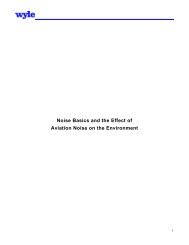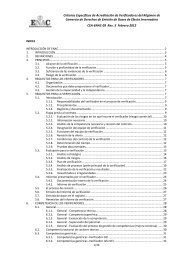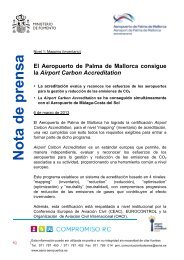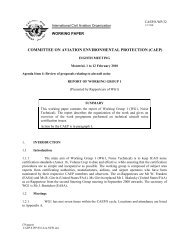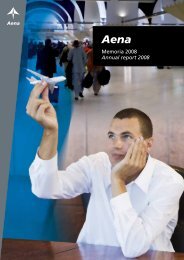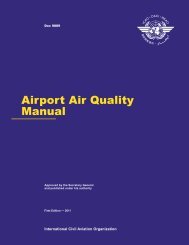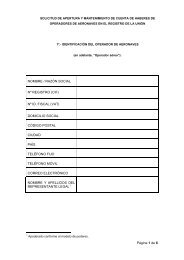Aircraft Maintenance Repair and Overhaul Market Study. - OBSA
Aircraft Maintenance Repair and Overhaul Market Study. - OBSA
Aircraft Maintenance Repair and Overhaul Market Study. - OBSA
- No tags were found...
You also want an ePaper? Increase the reach of your titles
YUMPU automatically turns print PDFs into web optimized ePapers that Google loves.
Executive SummaryA. IntroductionThe study was required to enable the Sponsors ofGlasgow Airport, Renfrewshire Council, Scottish EnterpriseRenfrew <strong>and</strong> BAA Glasgow, to gain a thoroughunderst<strong>and</strong>ing of the current <strong>and</strong> prospectiveEuropean aircraft maintenance, repair <strong>and</strong> overhaul(MRO) market. This underst<strong>and</strong>ing will allow themto take a systematic approach to the possible developmentof a new major MRO facility at GlasgowAirport.The last section of this study focuses on specific aspectsof the UK market that have particular relevanceto Glasgow Airport, but in principle the general marketanalysis could be applied to the establishmentof a new MRO facility at any of the airports in theregions of the other STRAIR partners. In that case,one would need to undertake additional analysis ofthe relevant market as well as possible additionalfactors <strong>and</strong> considerations. The analysis of thesefactors <strong>and</strong> considerations is not within the scope ofthis report, but it is safe to say that the broad conclusionsmay well apply to locations with similar labour<strong>and</strong> other cost levels as the Glasgow region.B. Outline of the <strong>Study</strong>The study begins with an outline of the air transportindustry’s growth prospects. The next two sectionsexamine the main issues involved in managing theMRO business <strong>and</strong> survey the current market in Europe.The final section explores some specific issuesrelating to the development of a new MRO facilityspecifically at Glasgow Airport.Air Transport Industry ForecastMSP Solutions has prepared its own growth forecastof the aviation industry. This estimates the numberof aircraft by various categories until 2035. The forecastwas developed using three steps:• A macro-economic forecast is developed using USDepartment of Energy assumptions for GDP growth<strong>and</strong> oil prices.• Traffic forecasts were then derived, using income<strong>and</strong> price elasticity factors.• Dem<strong>and</strong> for aircraft was then calculated from thetraffic forecast.The forecast covers the global fleet size. The numberof aircraft based in Europe is also forecast in somedetail by the various aircraft categories.The global fleet is expected roughly to triple to 44,000aircraft <strong>and</strong> the European fleet to nearly double. Inspite of the shift towards larger aircraft, more thanhalf of the aircraft in service in 2035 will be narrowbodies.This situation arises as availability of adequateflight frequencies is still judged to be critical,even in the maturing markets.A sensitivity analysis is also included in the study,using more cautious assumptions including the impactof steadily increasing oil prices. The resultinggrowth rates are roughly half of the mainstreamforecast. Nevertheless air traffic still manages todouble by 2035 <strong>and</strong> fleet size increases to nearly24,000, a still substantial growth rate of 60%.While the global fleet will continue to grow (even inthe alternative scenario) this does not mean thatthe MRO market will also grow. Over time the maintenancerequirements per aircraft are tending todecline because each generation of aircraft is engineeredto require less maintenance than the precedinggeneration.MRO Business IssuesMRO activity was initially the domain of the airlineswith very little work outsourced to independent providersor manufacturers. This situation has progressivelychanged over the years as increasing financialpressure on airlines has forced them to seek waysof reducing costs. Specialist MRO providers have developedwho can use the volume of their business<strong>and</strong> specialisation to do the work at lower unit cost,often by choosing locations with lower labour <strong>and</strong>set-up costs.A number of national airline carriers have withdrawnfrom the business totally by subcontractingwork. Other airlines such as Air France have separatedthe MRO operation from their airline business<strong>and</strong> transformed their engineering <strong>and</strong> maintenanceactivity into separate specialist companies. Finally,some airlines have continued doing work in-housein an integrated organisation.The traditional role of the MRO provider is alsochanging with much more of a total support functionrather than a one-off approach to the work.Increasingly, airlines are looking for a one-stopsolution based on a long-term commitment to theprovider. A good recent example of this was the 10-2STRAIR <strong>Aircraft</strong> <strong>Maintenance</strong> <strong>Repair</strong> <strong>and</strong> <strong>Overhaul</strong> <strong>Market</strong> <strong>Study</strong>. Glasgow International Airport.




